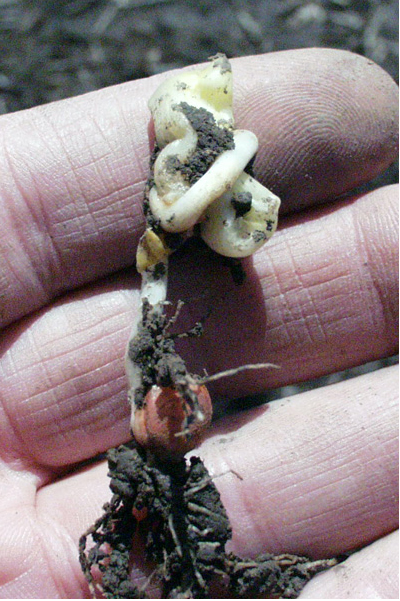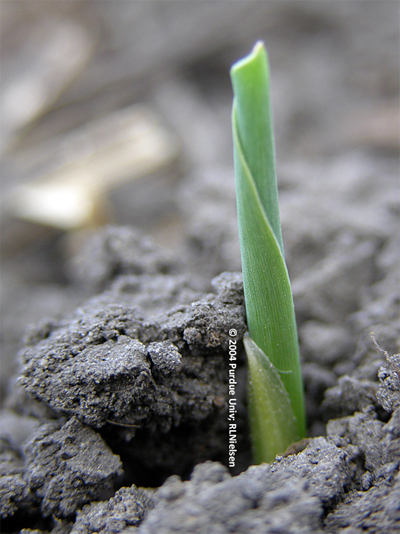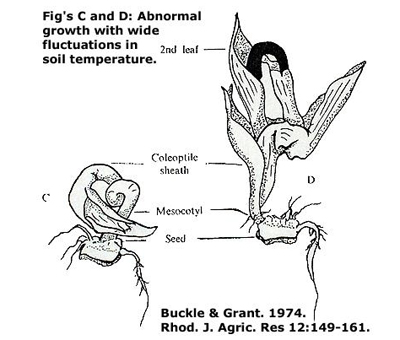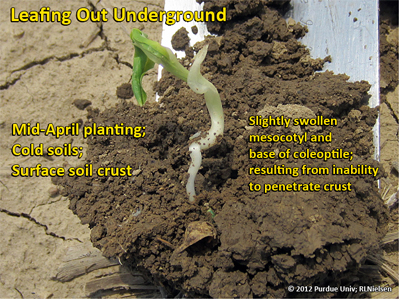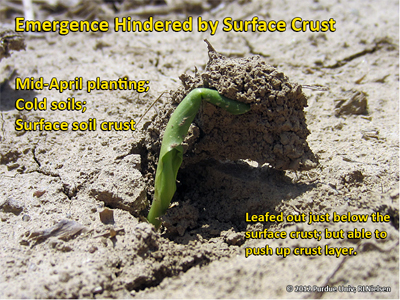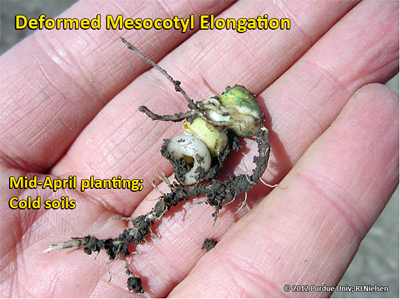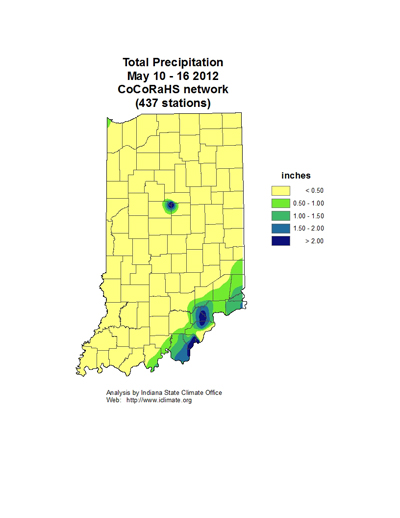Pest & Crop Newsletter, Entomology Extension, Purdue University
VIDEO: Assessing Early Bean Leaf Beetle Feeding – (Christian Krupke and John Obermeyer)
The bean leaf beetle awoke from its winter’s nap many weeks ago and have been feeding on forages and other legumes while waiting for soybean to be planted and emerge. Once plants have emerged throughout a field, beetles will typically dissipate to non-economic levels. Extensive cotyledon damage, while soybeans emerge, is cause for concern - if cotyledons are being destroyed before the unifoliolate leaves fully emerge or if the growing point is severely damaged, reduced yields from stand losses are possible. However, once unifoliolate and trifoliolate leaves are unfurled, defoliation of 40% or more can be tolerated without yield loss. These overwintering beetles are now naturally dying, as their eggs have been laid for the next generation of beetles to be seen sometime mid-season. Bottom line, this early feeding damage almost always looks worse than it really is.
![]()
Click here for the Blacklight Trap Catch Report
![]()
Poison Hemlock (Conium maculatum)-A Mini Review – (Travis Legleiter and Bill Johnson) –
We have received a couple of calls on poison hemlock this spring with concerns of its presence in the Indiana landscape. The appearance of poison hemlock on roadsides and fencerows of Indiana is not new, but the weed may be more prevalent this year as it came out of winter dormancy and has been rapidly growing since the unusually warm days of early March. I myself noticed it being one of the first plants to green up in the roadside ditches this winter as I traveled the state (Image 1). The presence of this weed is not new in Indiana as I can find articles in the Purdue weed science database back to 2003 on the subject of poison hemlock. The largest threat of this weed is the toxicity of it’s alkaloids if ingested by livestock or humans, but it can also be harmful to aesthetic values and has been reported to creep into no-till corn and soybean fields as well.
Image 1. Photo of a green and growing poison hemlock plant in a roadside ditch taken on March 7, 2012 in central Indiana.
Biology and Identification
Poison Hemlock is a biennual weed that exists as a low growing herb in the first year and bolts to three to eight feet tall in the second year and produces flowers and seed. It is often not noticed or identified as a problem until the bolting and reproductive stages of the second year. The alternate compound leaves are pinnate (finely divided several times) and are usually triangular in outline. Flowers are white and occur in an umbel inflorescence. Poison hemlock is often confused with wild carrot but can be distinguished by its lack of hairs and purple blotches that occur on the stems.
Toxic Properties
Poison hemlock contains five alkaloids that are toxic to humans and livestock if ingested and can be lethal. All parts of the plants contain the toxic alkaloids with levels being variable throughout the year. Symptoms of toxicity include nervousness, trembling, and loss of coordination followed by depression, coma, and/or death. Initial symptoms will occur within a few hours of ingestion.
Cases of poisoning due to poison hemlock ingestion are rare as the plants emit a mousy odor that makes it undesirable and unpalatable to livestock and humans. Consumption and toxicity in animals usually occurs in poorly managed or overgrazed pastures where animals are forced to graze poison hemlock.
Control
Control of poison hemlock with herbicide is most effective when applied to plants in the first year of growth or prior to bolting and flowering in the second year. The closer to reproductive stages, the less effective the herbicide. In roadside ditches, pastures, and waste areas, herbicides containing triclopyr (Remedy Ultra) or triclopyr plus 2,4-D (Crossbow) are most effective in controlling poison hemlock. Other herbicides that provide adequate control when applied at the proper timing are dicamba (Clarity, Banvel), metsulfuron-methyl (Cimarron, Escort XP), metsulfuron-methyl plus dicamba (Cimarron Max) and clopyralid plus 2,4-D (Curtail).
For information on control of poison hemlock in corn and soybean please refer to a previous Purdue Weed Science article: Poison Hemlock Control in Corn and Soybeans.
For further information on toxic plants in Indiana refer to the Purdue University Weed Science Guide to Toxic Plants in Forages.
![]()
Seedling Blights Observed in Indiana Cornfields – (Kiersten Wise) -
Indiana farmers got a head start on planting corn this year, and it seemed like everything was off to a great start. However, many fields planted in mid-April are now exhibiting uneven stands, stunted seedlings, and reduced vigor (Figure 1). There are several potential causes for these symptoms, including cold damage, nutrient deficiencies, herbicide or anhydrous ammonia injury, wireworms, and just “wet feet”. But, seedling blights caused by fungi or fungal-like organisms may also be to blame.
Seedling blights are prevalent when cool, wet soil conditions persist after planting. These conditions favor germination and infection by many of the organisms that cause soil-borne diseases. Cool, wet soils also slow plant growth and development and give diseases more time to infect and damage the seedling. However, in 2012, most farmers planted into dry soils. Even though moisture was not abundant at planting, our mid-late April cool-down lowered soil temperatures and slowed emergence. Rain events that occurred in late April and early May probably exacerbated these stresses and allowed fungal organisms to infect and damage seedlings.
Seedling blights are caused by a variety of soil or seed-inhabiting fungi. Infected seeds may rot after germination, preventing emergence, and plants that emerge have reduced root development and are often stunted. Roots of infected plants may be brown and discolored and can be soft or mushy. Infected plants may also have brown discoloration on the mesocotyl. It is difficult to determine in the field which disease is to blame for a specific case of seedling blight, and it may be necessary to submit a sample to get an accurate diagnosis. Two of the most common seedling blights of corn are caused by Pythium and Fusarium species. We have seen an increase in Pythium over the last few years, and it is possible that our Pythium population in Indiana is changing in some way. This could mean that a different species of Pythium is becoming more prevalent in Indiana, or it is possible the fungicide seed treatments used to control this disease vary in efficacy against our populations.
Now is the time to scout fields and assess the level of damage due to seedling blights. If damage is severe and considerable stand is lost, fields may need to be replanted. Please reference Purdue Agronomist Bob Nielsen’s article on replant decisions: <http://www.kingcorn.org/news/timeless/ReplantDecisions.html>.
Figure 1. Field with uneven stand due to seedling blight.
Prevalent Purple Plants Perennially Puzzle Producers – (Bob Nielsen) -
Like the swallows that return every year to San Juan Capistrano, it seems that purpling in young corn returns every year somewhere in Indiana. In recent days, I have received several reports of purpling from widely scattered areas of the state. While mildly attractive from an ornamental standpoint, landlords and tenants alike often become concerned when they see their fields take on a purplish hue that is clearly evident from the window of the pickup at 60 mph.
Biochemical Cause of Purpling. Purpling of corn plant tissue results from the formation of reddish-purple anthocyanin pigments that occur in the form of water-soluble cyanidin glucosides or pelargonidin glucosides (Kim, 1998). A hybrid’s genetic makeup greatly determines whether corn plants are able to produce anthocyanin. A hybrid may have none, one, or many genes that can trigger production of anthocyanin. That is the reason why purpling may appear in only one of two hybrids planted in the same field. Purpling can also appear in the silks, anthers and even coleoptile tips of a corn plant.
Agronomic Cause of Purpling. Well, you may say, that’s fine but what triggers the production of the anthocyanin pigments in young corn at this time of year? The answer is not clearly understood, but most agree that these pigments develop in young plants in direct response to a number of stresses that limit the plants’ ability to fully utilize the photosynthates produced during the day.
It has been my experience that the most common contributor to the development of purple corn plants is the combination of bright, sunny days and cool nights (40’s to 50’s°F) when corn plants are in the V3 to V6 stages of development (3- to 6-leaf collar stages). This combination translates to a lot of photosynthate produced during the day, but low rates of photosynthate metabolism during the night, that results in high concentrations of sugary photosynthates in the leaves. Since the anthocyanin occurs in the form of a sugar-containing glucoside, the availability of high concentrations of sugar in the leaves (photosynthesis during bright, sunny days) encourages the pigment formation. Hybrids with more anthocyanin-producing genes will purple more greatly than those with fewer “purpling” genes. In most cases, the purpling will slowly disappear as temperatures warm and the plants transition into the rapid growth phase (post-V6).
Rows of purple-leafed corn; late V3 stage of development
Hybrid differences for purpling; both plants V3
Hybrid differences for purpling
Other stresses that can restrict photosynthate metabolism in young corn plants include several that result in restricted root growth, including herbicide injury, severe phosphorus deficiency, soil compaction caused by tillage or planter traffic, excessively wet soils, excessively dry soils, insect injury, and disease injury. The negative effects of such root stresses on photosynthate metabolism can amplify the intensity of the purpling already triggered by a combination of cool nights and bright, sunny days.
What About Yield Losses? Does the leaf purpling lead to yield losses later on? It is important to recognize that the cause of leaf purpling, not the purpling itself, will determine whether yield loss will occurs.
If the main cause is simply the combination of bright, sunny days and cool nights, then the purpling will disappear as the plants develop further, with no effects on yield. If the major contributor to the purpling is restricted root systems, then the potential effects on yield will depend on whether the root restriction is temporary (e.g., cool temperatures & wet soils) or more prolonged (e.g., soil compaction, herbicide injury). Plants can recover from temporary root restrictions with little to no effect on yield. If the root stress lingers longer, the purpling may continue for some time and some yield loss may result if the plants become stunted.
If the primary cause is hybrid response to the combination of cool nights and bright, sunny days, the purpling symptoms will be spatially uniform throughout a field. If other stress factors are also restricting root development and/or function, then the purpling symptoms may be spatially variable throughout the field and correlated to soil type, drainage characteristics, or elevation of the landscape. Spatially variable patterns of purple corn may indicate the potential for lingering, yield-limiting stresses that should be more thoroughly investigated.
Related References
Chalker-Scott, Linda. 1999. Environmental Significance of Anthocyanins in Plant Stress Responses. Photochemistry and Photobiology 70(1): 1–9.
Christie, P.J., Alfenito, M.R., and Walbot, V. (1994). lmpact of low- temperature stress on general phenylpropanoid and anthocyanin pathways: Enhancement of transcript abundance and anthocyanin pigmentation in maize seedlings. Planta 194: 541-549.
Dixon, Richard A. and Nancy L. Paiva. 1995. Stress-lnduced Phenylpropanoid Metabolism. The Plant Cell 7:1085-1097. American Society of Plant Physiologists. [On-Line]. Available at <http://www.plantcell.org/cgi/reprint/7/7/1085> [URL accessed May 2012].
Kim, Jae Hak. 1998. Maize Anthocyanin Pathway. Pennsylvania State Univ. [On-Line]. Available at <http://scripts.cac.psu.edu/courses/plphy/plphy597_hef1/mpath.html> [URL accessed May 2012]. Editorial note: This link is for biochemistry fans!
Nielsen, R.L. (Bob). 2009. Reddish-Purple Corn Plants Late in the Season. Corny News Network, Purdue Univ. [online]. <http://www.kingcorn.org/news/timeless/PurpleCorn2.html> [URL accessed May 2012].
![]()
Corkscrewed Mesocotyls & Failed Corn Emergence – (Bob Nielsen) -
Successful stand establishment of a corn crop relies on many factors, including the successful emergence of the seedlings. Seedling emergence occurs as a result of elongation of the mesocotyl that elevates the coleoptile or “spike” toward the soil surface. If successful, the appearance of the coleoptile at or near the soil surface is synchronized with the emergence of the first true leaf from inside the coleoptile.
The mesocotyl is the white tubular stem-like plant part located between the kernel and the base of the coleoptile. Technically, the mesocotyl is the first true stem internode of the young corn seedling. As the coleoptile nears the soil surface, exposure to the red wavelengths of solar radiation causes a change in the supply of one or more growth hormones from the coleoptile to the mesocotyl tissue and mesocotyl elongation comes to a halt (Vanderhoef & Briggs, 1978). If mesocotyl elongation and/or coleoptile emergence are compromised, the emergence of the leaves from the coleoptile may occur underground and remain trapped by the soil.
Corkscrewed mesocotyl
Successful emergence of leaves from the coleoptile
Reports of leafing out underground in 2012, the year of record early planting, are beginning to accumulate now that growers are beginning to walk their early-planted fields. Such “leafing out underground” is obviously viewed with great consternation by growers who were hopeful for perfect emergence of their crop. Obviously, emergence failure directly impacts effective plant population; one of the major yield components of corn. The extent of the emergence failure in affected fields appears to range from about 5 to 20 percent of the planted population. The magnitude of the effect on grain yield will depend on the initial seeding rate, the severity of the problem, and growing conditions the remainder of the season. Very few affected fields, however, likely merit a decision to replant.
Failure to emerge successfully can be caused by failure of the mesocotyl to successfully elongate and/or by soil restrictions that hinder successful penetration of the soil by the coleoptile. In extreme cases, elongation of the mesocotyl fails miserably, resulting literally in corkscrewed fiascos. Often, more than one of the following causal factors exist in a problem field and usually interact with each other to amplify the problem.
Kernel Position in Furrow: The coleoptile, the protective covering for the plumule leaves, emerges from the embryo side of the kernel and moves toward the dent end of the kernel by virtue of the elongation of the mesocotyl. The position of the kernel in the furrow with respect to the embryo face directly influences the initial location where the coleoptile emerges. If the kernel lands with the embryo face down in the furrow, the coleoptile emerges on the bottom side of the kernel, elongates horizontally until the mesocotyl “clears” the end of the kernel, then finally begins its upward ascent. Such an “upside-down” beginning might contribute to a seedling’s susceptibility to other corkscrewing causal factors.
Restricted Emergence: Corkscrewed mesocotyl/coleoptile development can result when the coleoptile encounters resistance as the mesocotyl elongates. Severe soil crusting or otherwise dense soil surface and cloddy soil surfaces can cause such resistance. A combination of severe sidewall compaction plus press wheel compaction over the furrow can also restrict coleoptile emergence and force the mesocotyl to elongate in unusual directions.
Herbicide Injury: Certain herbicides, notably cell growth inhibitors like acetochlor, can affect seedling shoot development especially if weather or soil conditions are not conducive for rapid seedling growth. However when herbicide injury is suspected to be a contributing factor, cool soils and dense soil crusting are often also contributing factors, so is difficult to pin the blame completely on the herbicide injury.
Cold Soils: Cold soils and/or wide fluctuations in soil temperatures throughout the day during the emergence process are also thought to be major contributing factors for the development of corkscrewed mesocotyl development (Buckle & Grant, 1974). The exact minimum soil temperatures that can cause such corkscrewed development are not clearly documented, but clearly it is not uncommon in Indiana for daily soil temperatures to dip as low as 40F during April and early May. Furthermore, bright sunny days can elevate bare soil temperatures quite high but still drop quite low the following night and thus result in a wide diurnal fluctuation in soil temperatures. Dry soils would be more prone than wetter soils to wide swings in daily soil temperatures.
Corny Trivia: Cold temperature injury that results in corkscrewed mesocotyls is not exactly the same as that which is referred to as “imbibitional chilling” injury. The latter refers to cold injury to the seed during the first 24 to 72 hours after planting when the seed is imbibes (aka absorbs) water. Imbibition of water causes the seed to swell. If seed cell tissue is very cold, it may become less elastic and thus may rupture during the swelling process. The most common symptom of such imbibitional chilling damage to seed cell tissue is often simply swollen seed with little to no evidence of germination progress. Conversely, seedlings with corkscrewed mesocotyls germinated successfully. The cold temperature damage occurred slightly late.
Abnormal growth with wide fluctuations in soil temperature
Natural curved elongation of the mesocotyl due to seed placed embryo face down in the furrow
Leafing out underground; caused primarily by dense surface soil crust
Partial leafing out underground; caused primarily by dense surface soil crust
Partial leafing out underground; caused primarily by dense surface soil crust
Deformed mesocotyl elongation caused primarily by cold soil temperatures
Related Reading
Bradley, Kevin. 2009. Cool, Wet Soils Can result in More Corn Injury from Preemergence Residual Herbicides. Integrated Pest & Crop Management Newsletter, Univ. of Missouri. [on-line]. Available at <http://ppp.missouri.edu/newsletters/ipcm/archives/fullissue/v19n8.pdf> [URL accessed May 2012].
Buckle, Janet and Penelope Grant. 1974. Effects of Soil Temperature on Plumule Growth and Seedling Emergence of Maize (Zea mays L.). Rhod. J. Agric. Res. 12: 149-161.
Elmore, Roger. 2012. Imbibitional Chilling and Variable Emergence. Integrated Crop Management News, Iowa State Univ. online at <http://www.extension.iastate.edu/CropNews/2012/0511elmore.htm> [URL accessed May 2012].
Nielsen, RL (Bob). 2010. The Emergence Process in Corn. Corny News Network, Purdue Univ. Online at <http://www.kingcorn.org/news/timeless/Emergence.html> [URL accessed May 2012].
Nielsen, RL (Bob). 2012. Early-Planted Corn & Cold Weather. Corny News Network, Purdue Univ. Online at <http://www.kingcorn.org/news/articles.12/EarlyCornColdWthr-0412.html> [URL accessed May 2012].
Vanderhoef, Larry N., and Winslow R. Briggs. 1978. Red Light-inhibited Mesocotyl Elongation in Maize Seedlings. I. The Auxin Hypothesis. Plant Physiology 61: 534-537.
![]()
Corn Replant Decisions – (Bob Nielsen) –
Crappy stands of corn (aka less than desirable) occur somewhere in Indiana every year. Unacceptable stand establishment in some of these fields may eventually require growers to make decisions about replanting. Deciding to replant a crappy stand of corn should be based on a number of criteria, but unfortunately the most common is often the grower›s emotion associated with looking out the kitchen window at the damaged field every morning or driving by the field every afternoon taking the kids to baseball practice.
Making a wise decision about the merits of replanting a damaged field of corn requires more than emotions. In fact, I would rather that emotions be taken out of the equation entirely. Toward that end, I developed a replant decision-making worksheet that assists growers and farm managers in making that important replant decision. The worksheet allows you to determine the damaged field›s current yield potential (if left untouched), its replant yield potential, and the dollar returns (if any) from replanting the field.
The worksheet is included in a larger overall publication on corn replanting titled «Estimating Yield and Dollar Returns From Corn Replanting». This Purdue Extension publication (AY-264-W) is available as a PDF-formatted download from the Web at <http://www.agry.purdue.edu/ext/pubs/AY-264-W.pdf>.
Some of the information that is required to complete the worksheet originates from cropping records and history, including the original seeding rate and planting date for the damaged field. Some of the required worksheet inputs are frankly estimates, including what the field would have yielded under “normal” conditions if it had not been damaged and what market price you expect to receive for the grain after harvest. The expected replanting date and replanting costs are also required for the worksheet calculations.
- Recognize that the expected replanting date may be uncertain if the field is too wet to replant today and the forecast is for a lot of rainy weather. An accurate estimate of the replanting date is important because it influences the estimate of yield relative to “normal” and, thus, the estimate of dollar returns from replanting.
- Recognize that there is no guarantee of success for later-planted replanting situations. Late-planted fields will pollinate during late summer when high temperatures and moisture deficits are more common. Late-planted fields are often more attractive to late flights of European corn borer, so make sure you consider hybrids with Bt corn borer trait technology. Late-planted fields can also be more susceptible to fall frost damage if the corn does not reach physiological maturity prior to the occurrence of damaging temperatures, so choose replant hybrid maturities wisely (Nielsen & Thomison, 2002).
- Recognize that the costs of replanting a damaged stand may include additional herbicide or tillage to eliminate the surviving plants in the crappy stand. Simply replanting through an existing, crappy stand of corn is not always a wise decision because the original plants of the crappy stand can significantly compete with the newly emerged replant seedlings and reduce their yield potential. My opinion, supported by empirical evidence, is that unless the surviving population of the original crappy stand is significantly less than 50% of the intended original population, you ought to take steps to eliminate those plants prior to replanting the field. Unfortunately, “taking out” the original plants is not as simple as it was years ago because of today’s transgenic herbicide-tolerant traits. If the original hybrid planted in the field contains Roundup-ready™ or LibertyLink™ traits, you will not be able to use glyphosate or glufosinate herbicides to “burn down” the original, poor stand of corn. In addition to cold, hard steel (aka tillage), there are a limited number of herbicide options for killing crappy stands of these herbicide-tolerant hybrids (Johnson et al., 2010), but some require a significant waiting period before replanting the field. Corn older than about V3 (three leaf collars) will also generally be much more difficult to “take out” with these alternative herbicides.
Finally, some information is required for the worksheet calculations from the damaged field itself. You will need an estimate of the surviving plant population that is representative of the damaged areas of the field. Depending on the nature of the crappy stand, you may also need estimates of after-damage stand uniformity and plant defoliation.
I will be the first to admit that it takes some time and patience to complete the replant worksheet; both of which are usually in short supply at the time the decision is being made. Recognize, though, that much of the replanting that occurs every year throughout the state is based primarily on emotion and not on estimates of economic returns. Taking the time to work through the steps of my replanting worksheet will help clarify the economic returns (or losses) to replanting and reduce the influence of emotions in this important crop management decision.
Related Reading
Johnson, Bill, Tom Jordan, & Glen Nice. 2010. Methods to Control Volunteer Roundup Ready or Glyphosate-Tolerant Corn in a Corn Replant Situation. Botany & Plant Path. Dept, Purdue Univ. Online at <http://www.btny.purdue.edu/WeedScience/2010/VolCorn2010.pdf>. [URL accessed 2012].
Nielsen, RL (Bob). 2003. Estimating Yield and Dollar Returns From Corn Replanting. Purdue Univ. Cooperative Extension Service publication AY-264-W. Online at <http://www.agry.purdue.edu/ext/pubs/AY-264-W.pdf>. [URL verified 5/15/06].
Nielsen, R.L. (Bob). 2012. A Recipe for Crappy Stands of Corn. Corny News Network, Purdue Univ. Online at <http://www.kingcorn.org/news/timeless/CrappyStands.html>. [URL accessed May 2012].
Nielsen, Bob and Peter Thomison. 2003. Delayed Planting & Hybrid Maturity Decisions. Purdue Univ. Cooperative Extension Service publication AY-312-W. Online at <http://www.agry.purdue.edu/ext/pubs/AY-312-W.pdf>. [URL verified 5/15/06].
![]()
A Recipe for Crappy Stands of Corn* - (Bob Nielsen) –
Every year, I get a lot of phone calls from folks wanting to know why their neighbor's fields of corn ended up with such poor uneven lousy-looking stands. Since some seem so ecstatic about this happening to their neighbors, I figured maybe they would like to know how to prepare a crappy stand of corn for themselves next year.
The following recipe will prepare one helping of a crappy stand of corn. Add more acreage as desired.
Ingredients:
- One (1) field, level and poorly drained.
- Wait until the last possible moment to burn down any winter annual weeds or cover crops.
- Plant one (1) or more hybrids of your choice, but preferably ones with poor seed quality and low vigor.
- Do NOT add any starter fertilizer to the recipe.
- However, an ample amount of starter fertilizer placed right next to the seed will add a little “zing” to the recipe.
- Add a dash of seed rot or seedling blight organisms.
- Add a pinch of wireworms or seedcorn maggots.
- Plenty of spring tillage to maximize soil compaction, though one pass with a disc will suffice if the soil is “on the wet side” when worked.
- Flavor with acetanilide or growth regulator herbicides as desired.
- Add minimum of one inch of rain per week after planting to maintain saturated soil conditions.
- Top off with one or more severe frost events to provide a nice, crisp appearance to the plants.
Mix well and plant as early as possible no matter how cold or wet the soils. Maintain average daily soil temperatures at 50oF or less for three weeks or more after planting. Plant “on the wet side” to ensure good sidewall compaction. Plant either excessively deep or excessively shallow. Plant as fast as you possibly can to ensure uneven seed drop. For best results, follow corn with corn, especially with minimal fall tillage. Top off with a thick soil crust and serve cold.
Will serve 6 people (farmer, fertilizer & ag chemical dealer, industry tech rep, seed dealer, county agent, university specialist) and amuse the entire neighborhood.
* Disclaimer: This recipe is provided “tongue in cheek” as a reminder that stand establishment is one of the most important phases of the entire corn growing season. Success or failure during stand establishment impacts not only final plant population but also ear size determination once the crop moves into the rapid growth phase. Let’s be careful out there!
Related Reading
Nielsen, RL (Bob). 2012. Corn Replant Decisions. Corny News Network, Purdue Univ. Online at <http://www.kingcorn.org/news/timeless/ReplantDecisions.html>. [URL accessed May 2012].
![]()






